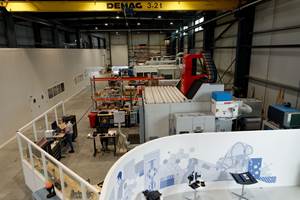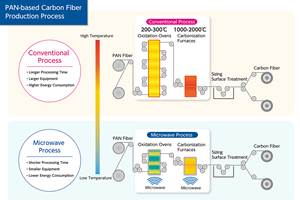Covestro targets 60% greenhouse gas emissions reduction by 2030
Cutting emissions from production, external energy sources, and upstream and downstream processes in the value chain, as well as offering climate-neutral product versions centralizes Covestro’s full circularity goals.
Covestro (Leverkusen, Germany) has focused its corporate vision on becoming fully circular, a goal being pursued by companies globally, including within the composites industry. To this end, the materials manufacturer wants to completely align its entire production and product range to this concept. One concrete measure on this path is climate neutrality. Already in 2021, Covestro reports that it has cut specific greenhouse gas (GHG) emissions, those generated per metric ton of product produced, by 54% compared to 2005, and thus overachieved its previous sustainability target set for 2025.
Covestro has now defined a further target: the group aims to become climate neutral and achieve net-zero emissions by 2035 for scope 1 and scope 2, in accordance to meeting the goal of the Paris Climate Agreement. On the path to achieving this goal, the company plans to cut GHG emissions from its own production (scope 1) and from external energy sources (scope 2) by 60%2 to 2.2 million metric tons by 2030. In addition, indirect GHG emissions from upstream and downstream processes in the value chain (scope 3) will be further reduced. Covestro intends to announce a reduction target for this by 2023.
“Sustainability cannot be done alone and will require a greater effort from everyone to achieve the goals of the Paris Climate Agreement.”
To achieve net-zero emissions, Covestro anticipates dedicated investments of an accumulated €250 million to €600 million by 2030, resulting in lower operating expenses of expected €50 million to €100 million annually due to growing energy efficiency. On its path to achieve net-zero emissions, Covestro also expects an increase in operating expenses in the magnitude of a low three-digit million EUR amount annually. These cost assumptions are based on the historic experience that prices for fossil-based energies are lower than prices for renewable energies.
“For the past two years, we have been working at full speed on our vision to become fully circular. We have already reached important milestones on this path and continue to set ourselves ambitious goals,” notes Dr. Markus Steilemann, chief executive officer (CEO) of Covestro. “Sustainability cannot be done alone and will require a greater effort from everyone to achieve the goals of the Paris Climate Agreement. Policymakers, business and society must work together to achieve ambitious climate goals.”
According to the company, three levers make a vital contribution to achieving the climate targets:
- Production processes will be improved further and energy efficiency enhanced to achieve even more sustainable manufacturing. One focus is on reducing nitrous oxide emissions. That will be possible through greater use of innovative catalyst technology. In addition, production plants can be controlled more efficiently thanks to further digitalization of the facilities and the use of digital technologies, while processes can be optimized using digital simulations. Digital technologies also help collect and track emissions data throughout the value chain.
- Covestro’s production sites worldwide are to be gradually converted to renewable electricity. That includes the use of offshore wind power, backed, for example, by a supply agreement with the energy provider Ørsted (Fredericia, Denmark), which will cover 10% of the electricity required by the company’s sites in Germany from 2025 and onward. Onshore wind energy will also be used, for example under the power purchase agreement with Engie SA (La Défense, France), that covers 45% of the electricity needs of the Covestro site in Antwerp, Belgium. About 10% of the electricity Covestro needs in Shanghai, China, already comes from the solar parks of Datang Wuzhong New Energy Co. In addition to the existing cooperation models with power suppliers, further agreements are being planned in order to achieve a net-zero carbon footprint.
- Steam is an important energy source for chemical production processes. Converting steam generation from fossil to renewable energy sources is a challenge that Covestro intends to solve by various routes. To this end, the company is looking into the use of biogas and green natural gas as an energy source to generate renewable steam. Green hydrogen and green ammonia or green electricity could also be used as energy source for steam generation.
- Covestro is updating and expanding its existing management system at the start of fiscal year (FY) 2022. The group is also adding a sustainability component, measured by direct and indirect greenhouse gas emissions (scope 1 and 2) in 2022. Reducing GHG emissions (scope 1) has been a key performance indicator (KPI) used as a component top management’s long-term compensation since January 2021.
Focused on customer centricity, Covestro says it is already expanding its portfolio of climate-neutral products continuously. The company refers to its climate-neutral MDI — a raw material for making rigid polyurethane (PU) foam — and climate-neutral polycarbonate, made using raw materials from mass-balanced organic waste and residual materials as well as renewable energy, as prime examples of this.
References
1 Achieving net zero greenhouse gas emissions is defined, as a balance between anthropogenic GHG emissions (from own operations and energy procurement) and anthropogenic greenhouse gas removals.
2 Reference value: base year 2020, 5.6 million metric tons of GHG emissions.
Related Content
Composites end markets: Electronics (2024)
Increasingly, prototype and production-ready smart devices featuring thermoplastic composite cases and other components provide lightweight, optimized sustainable alternatives to metal.
Read MoreNovel composite technology replaces welded joints in tubular structures
The Tree Composites TC-joint replaces traditional welding in jacket foundations for offshore wind turbine generator applications, advancing the world’s quest for fast, sustainable energy deployment.
Read MorePlant tour: Daher Shap’in TechCenter and composites production plant, Saint-Aignan-de-Grandlieu, France
Co-located R&D and production advance OOA thermosets, thermoplastics, welding, recycling and digital technologies for faster processing and certification of lighter, more sustainable composites.
Read MoreMicrowave heating for more sustainable carbon fiber
Skeptics say it won’t work — Osaka-based Microwave Chemical Co. says it already has — and continues to advance its simulation-based technology to slash energy use and emissions in manufacturing.
Read MoreRead Next
Plant tour: Daher Shap’in TechCenter and composites production plant, Saint-Aignan-de-Grandlieu, France
Co-located R&D and production advance OOA thermosets, thermoplastics, welding, recycling and digital technologies for faster processing and certification of lighter, more sustainable composites.
Read MoreDeveloping bonded composite repair for ships, offshore units
Bureau Veritas and industry partners issue guidelines and pave the way for certification via StrengthBond Offshore project.
Read MoreAll-recycled, needle-punched nonwoven CFRP slashes carbon footprint of Formula 2 seat
Dallara and Tenowo collaborate to produce a race-ready Formula 2 seat using recycled carbon fiber, reducing CO2 emissions by 97.5% compared to virgin materials.
Read More

























